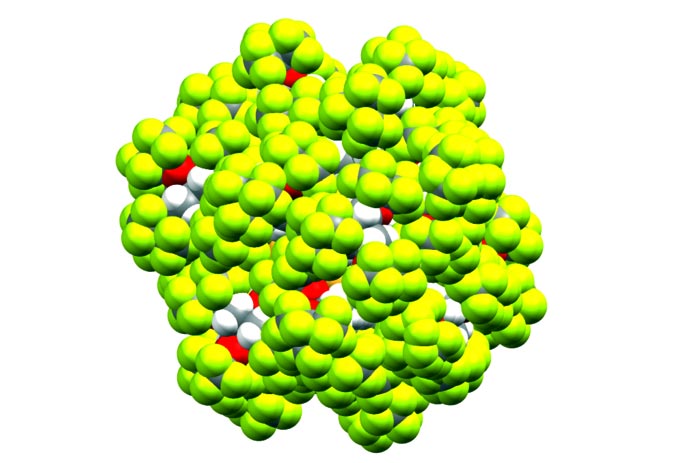A new nanomaterial for precision medicine and the green transition

Representation of the nanocluster
Credit: Politecnico di Milano
In Nature Communications: The Politecnico di Milano study that synthesised a nanocluster of superfluorinated gold for the first time.
The SupraBioNano Lab (SBNLab) at the Politecnico di Milano’s Department of Chemistry, Materials and Chemical Engineering “Giulio Natta”, in partnership with the University of Bologna and the Aalto University of Helsinki (Finland) has, for the first time, synthesised a superfluorinated gold nanocluster, made up of a core of only 25 gold atoms, to which 18 branch-structured fluorinated molecules are linked. The project was recently published in the prestigious Nature Communications magazine.
The metal clusters are an innovative class of very complex nanomaterial, characterised by ultra-small dimensions (<2nm) and peculiar chemical-physical properties such as luminescence and catalytic activity, which encourage its application in various scientific fields of high importance in relation to modern global challenges. These include precision medicine, in which metal nanoclusters are used as innovative probes for diagnostic and therapeutic applications, and the energy transition, where they are applied as efficient catalysers for the production of green hydrogen.
The crystallisation of metal nanoclusters offers the possibility of obtaining high-purity samples, allowing their fine atomic structure to be determined; however, at present this remains a very difficult process to control. The methodologies developed in this study promoted the crystallisation of nanoclusters, allowing their atomic structure to be determined by means of x-ray diffraction at the Sincrotrone Elettra in Trieste. The end result is the structural description of the most complex fluorinated nano-object ever reported.
“Thanks to the presence of a completely fluorinated shell, containing almost 500 fluorine atoms, the gold nanocluster is stabilised by the numerous interactions between the fluorine atoms of the binder, encouraging crystallisation”, states professor Giancarlo Terraneo.
“It will soon be possible to study the structure of these advanced nanomaterials at the Politecnico di Milano, where – thanks also to the grant from the Region of Lombardy – Next-GAME (Next-Generation Advanced Materials), a laboratory dedicated to the use of state-of-the-art x-ray instruments to characterise crystals, nanoparticles and colloids, is being established”, concludes professor Pierangelo Metrangolo, on behalf of Next-GAME.
The interactions between the fluorine atoms both within the nanocluster and between the nanoclusters were rationalised using quantum chemistry techniques at the University of Bologna’s “G. Ciamician” Chemistry Department by Dr Angela Acocella and professor Francesco Zerbetto.
Professor Valentina Dichiarante, professor Francesca Baldelli Bombelli, Dr Claudia Pigliacelli and professor Giulio Cerullo, from the Politecnico di Milano’s Physics Department, also contributed to the study, looking at the nanocluster’s optical characteristics and demonstrating the fluorinated binders’ impact on the gold core’s optical activity.
The “High-resolution crystal structure of a 20 kDa superfluorinated gold nanocluster” study, C. Pigliacelli et al. Nat. Commun. 2022, 13, 2607 is available at the following link: https://www.nature.com/articles/s41467-022-29966-2
Journal: Nature Communications
DOI: 10.1038/s41467-022-29966-2
Method of Research: Experimental study
Subject of Research: Not applicable
Article Title: High-resolution crystal structure of a 20 kDa superfluorinated gold nanocluster
Article Publication Date: 11-May-2022
All latest news from the category: Life Sciences and Chemistry
Articles and reports from the Life Sciences and chemistry area deal with applied and basic research into modern biology, chemistry and human medicine.
Valuable information can be found on a range of life sciences fields including bacteriology, biochemistry, bionics, bioinformatics, biophysics, biotechnology, genetics, geobotany, human biology, marine biology, microbiology, molecular biology, cellular biology, zoology, bioinorganic chemistry, microchemistry and environmental chemistry.
Newest articles

A universal framework for spatial biology
SpatialData is a freely accessible tool to unify and integrate data from different omics technologies accounting for spatial information, which can provide holistic insights into health and disease. Biological processes…

How complex biological processes arise
A $20 million grant from the U.S. National Science Foundation (NSF) will support the establishment and operation of the National Synthesis Center for Emergence in the Molecular and Cellular Sciences (NCEMS) at…

Airborne single-photon lidar system achieves high-resolution 3D imaging
Compact, low-power system opens doors for photon-efficient drone and satellite-based environmental monitoring and mapping. Researchers have developed a compact and lightweight single-photon airborne lidar system that can acquire high-resolution 3D…





















